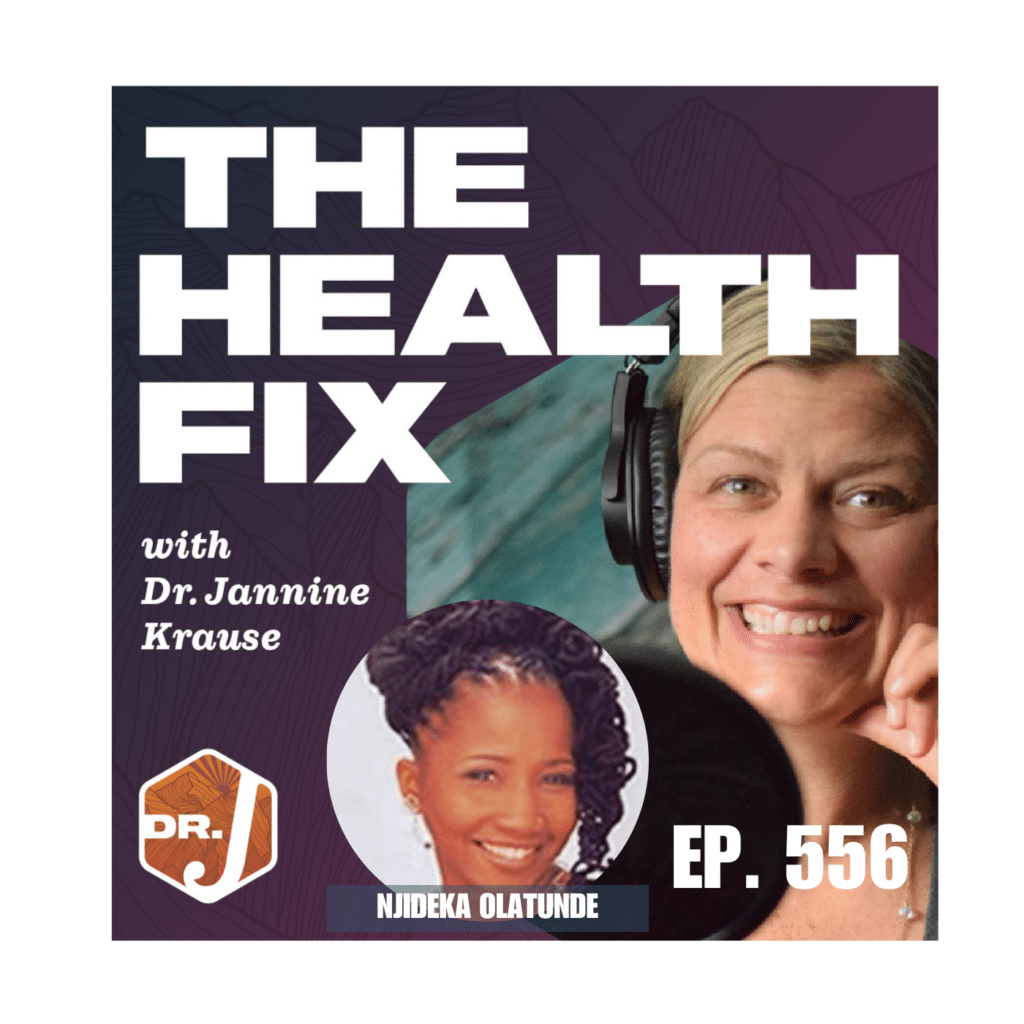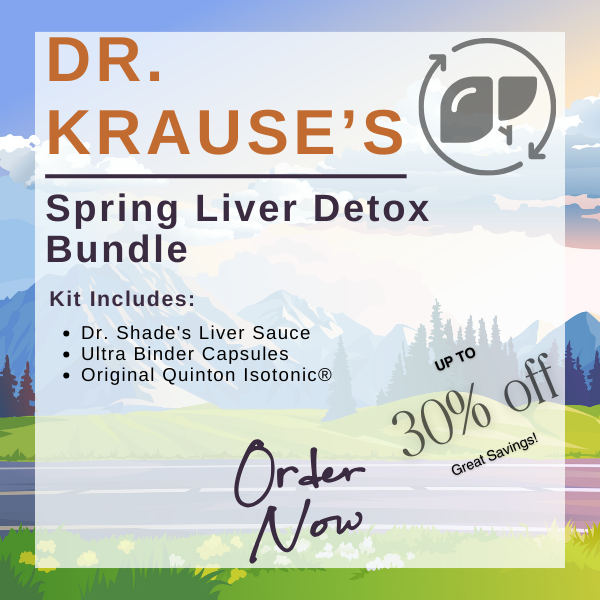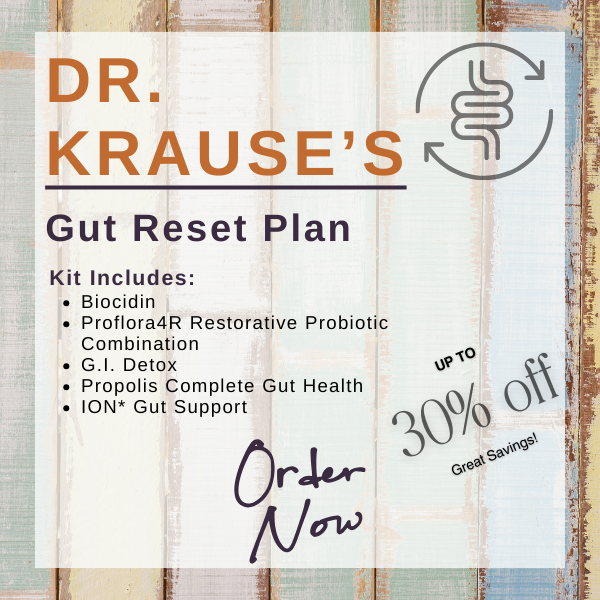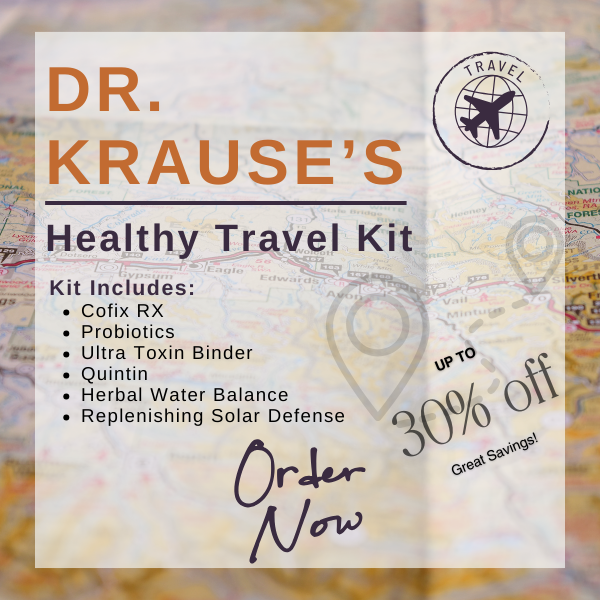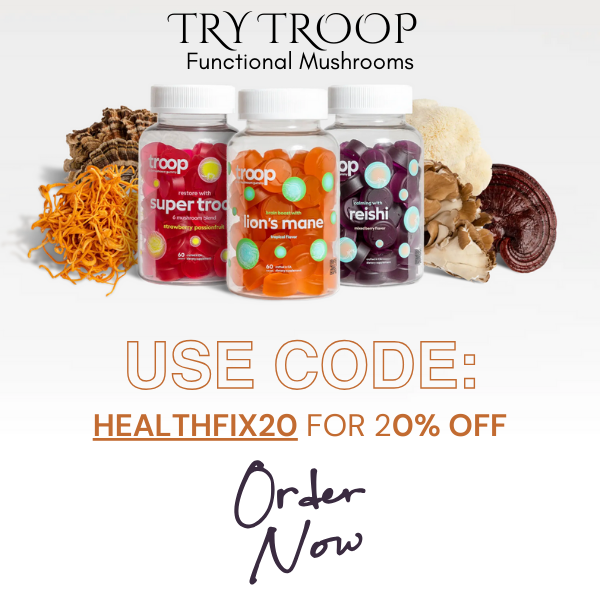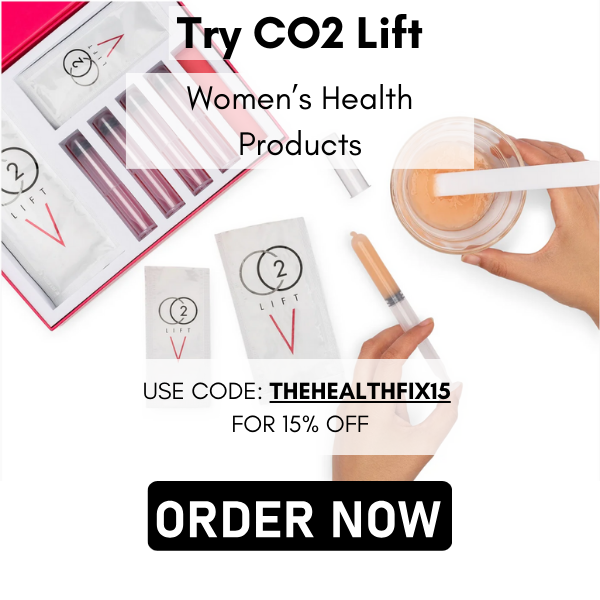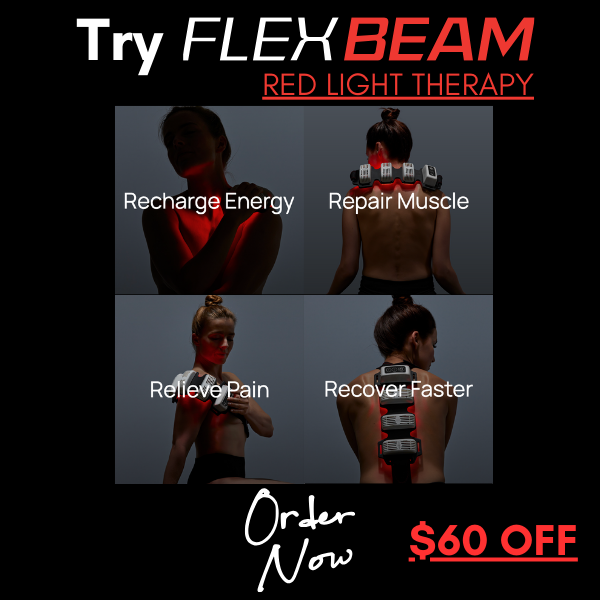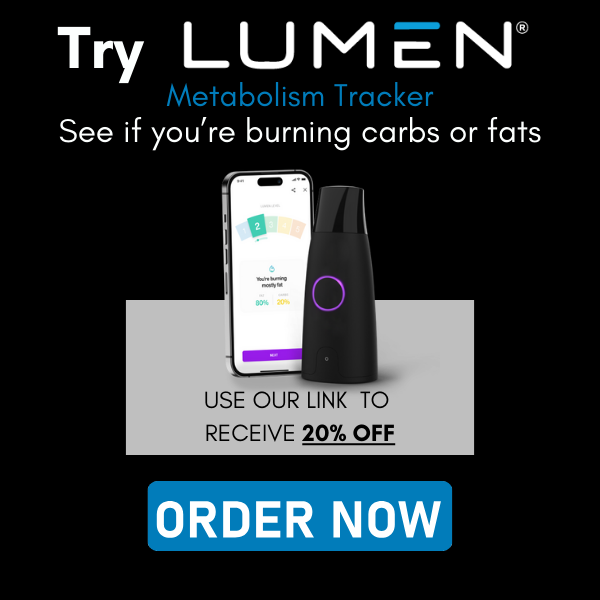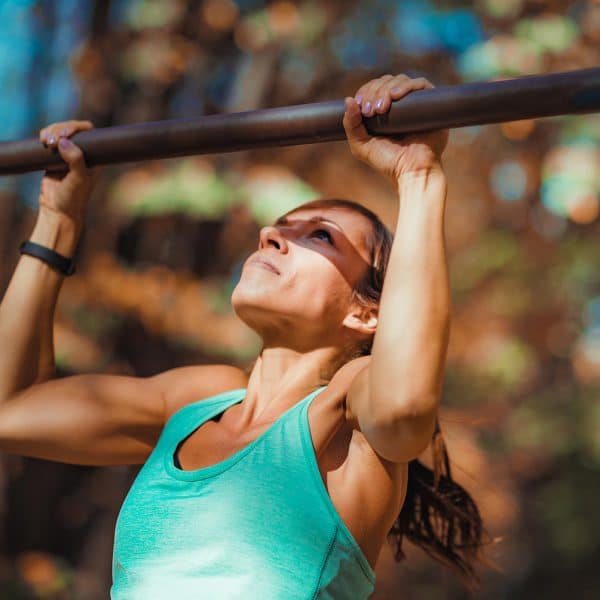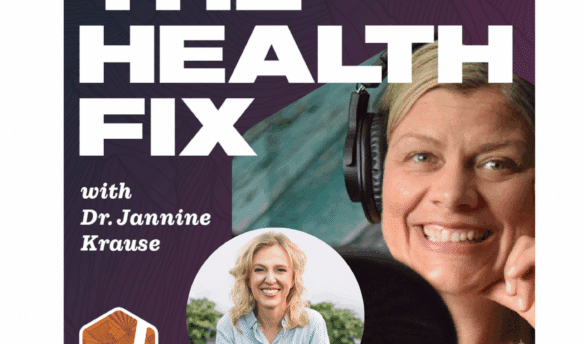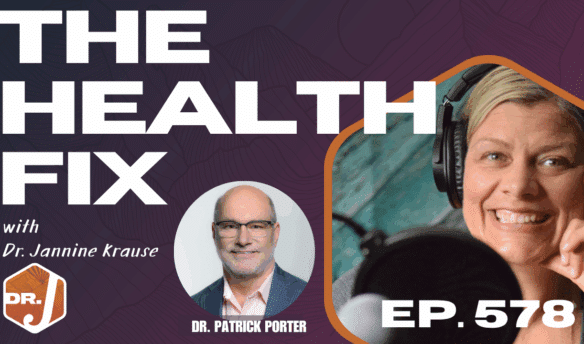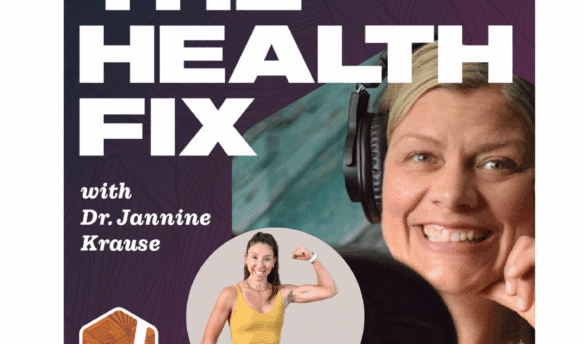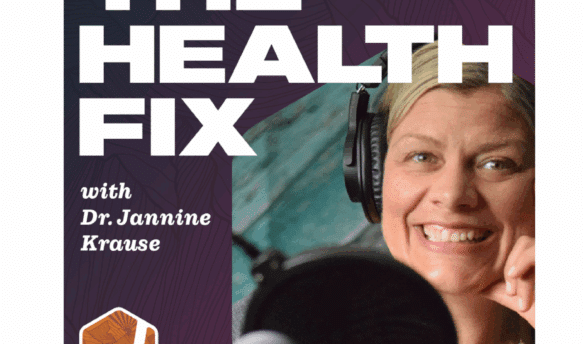In this episode of the Health Fix Podcast, Dr. Jannine Krause interviews Njideka Olatunde, an expert in reflexology, who shares her journey into the practice and its profound impact on healing. They discuss the connection between pain and stress, the importance of touch in healing, and how reflexology can be a family practice. Njideka emphasizes the need for emotional health, especially during menopause, and highlights her current research projects aimed at integrating reflexology into conventional medicine. The conversation underscores the holistic approach to health, focusing on the mind-body-spirit connection and the power of touch.
Dr. Krause’s Protocols
Instructions Included
Traveling soon? Looking to detox or reset your gut? Try one of Dr. Krause’s Fullscript plans.
What You’ll Learn In This Episode:
- How touch is essential for emotional and physical well-being.
- Why teaching children reflexology is crucial for the entire family.
- How reflexology can serve as a preventive measure in family health.
- The power of using reflexology to lower chronic pain
Resources From The Show:
Our Partners
Podcast Transcript
Chapters
00:00 Introduction to Reflexology
04:10 Njeka’s Journey into Reflexology
09:30 Understanding Pain and Stress Connection
17:14 The Role of Touch in Healing
24:27 Reflexology as a Family Practice
31:44 Navigating Menopause and Emotional Health
34:25 Current Projects and Research in Reflexology
40:40 The Mind-Body-Spirit Connection
Dr. Jannine Krause (00:01.287)
Hey health junkies, I have Njdeka Olatunde on the podcast today and we are going to be talking about reflexology and I can’t wait to dive into that. So Njdeka, welcome to the Health Fix Podcast.
Njideka Olatunde (00:12.29)
Thank you so much for having me and I’m looking forward to sharing with your listeners.
Dr. Jannine Krause (00:17.723)
Well, you know, we have not talked about reflexology pretty much maybe like some blurbs, but not talking about it in depth. And I see you have a book, so we’re definitely gonna have to talk about that as well because I like giving folks resources once they’ve heard about concepts. And a lot of people probably have heard about reflexology. Maybe we see it at spas as an offering and we’re like, that’s cool. Or where I hail from in Washington state, we have a lot of reflexology clinics where we have…
Njideka Olatunde (00:25.923)
Mm-hmm.
Dr. Jannine Krause (00:47.197)
Chinese folks doing some of the work. So how did reflexology come to you? How did you two meet up? What happened?
Njideka Olatunde (00:55.438)
Okay, I guess the probably the best way I can answer that question is as a child My mother used to always do back rubs hand rubs and foot rubs or my brother and I and it wasn’t until Some years ago. My brother told me that
as a child, that’s what kind of laid the seed for you to move into reflexology. And the essence of that happened because I grew up on home remedies. And back then, you know, doctors used to come to your home for visits and I saw a doctor as being a healer. So I said, okay, that’s what I want to do when I grew up. I want to be a healer, but really what, what actually kind of happened
I had the opportunity because I was interested in studying my ancestral connections and I have Native American and African ancestry. And so I happened to do what was known as a vision quest as it relates to my Native American connection. And I did this vision quest and it happened to be in Spokane, Washington. And I had to go to
they placed you on a special spot on the mountain and you were there by yourself. And for me, coming from Washington DC, an urban background, I knew nothing about the outdoors or camping or none of that. That was my first introduction. And so with that, what happened was you were placed on this spot and you had to be about connecting with nature.
And my major fear was snakes. I’m saying, I said, okay, I’m out here. What am I gonna do about that? But the essence of it, to bring it all together was staying in that spot. It was about you reconnecting with yourself. And one of the things that happened while I was there, it was always butterflies that were flying around and they kept coming around me and.
Njideka Olatunde (03:14.854)
this was over with you went back and so the Native Americans were able to explain and translate your experience because what you were doing you were journaling and writing down everything and so the butterfly represented that I was a part of the butterfly clan so and I’ve always liked butterflies so that stated that but they also told me that my healing was going to come from my hands
and I need to look to my hands. And so basically I thought that meant reflexology. I mean, I thought that meant massage therapy. But when I went to massage school, I didn’t really like massage, but I fell in love with the reflexology. And from there, it evolved to what it is that I do today and have been doing for almost like 40 plus years.
Dr. Jannine Krause (04:10.619)
Wow, you know, it’s so fascinating. You know, I don’t know too many women that don’t like their feet rubbed, right? And we don’t know, you know, if our husband’s doing our partner’s doing it, you know, maybe it’s not so great, but just even just some touch, right? On those feet can, it just sends you to a different place than someone squeezing on those muscles on your neck and you’re like, it hurts.
Njideka Olatunde (04:29.56)
Yes.
Njideka Olatunde (04:32.906)
Exactly, yes. The essence of it is, which I always tell folks, the most overused and abused parts of our body are our hands and feet. So just being able to touch your hands and touch your feet is very stimulating and very healing for the whole body from head to toe.
Dr. Jannine Krause (04:59.293)
Absolutely. I’ve found, you know, going back, I’ve kind of went back and forth between being more virtual and doing more acupuncture in my practice and then back, you know, kind of going back and forth and I really found that I do like the hands-on and I feel like people just…
Njideka Olatunde (05:11.544)
Yes.
Dr. Jannine Krause (05:19.001)
There’s a little bit of a transformation. We’re almost like helping the body go somewhere or get the information it needs. You know, I’m not saying, and this is something I know I’ve heard you say in other podcasts is that, you know, we’re not necessarily the healers. We’re just the guides here of sorts. And I know I’m not saying your exact words. So I would love for you to kind of bridge the gap between touching hands, touching feet. What are the messages? I’m sure people have seen the maps on the hands and feet, but I would love to hear your version.
of what’s happening when you’re touching someone’s foot.
Njideka Olatunde (05:53.422)
Well, what I like to, I always like to share in terms of we talk about understanding. The essence of reflexology is really focusing on how…
the body responds to the communication via the nerve endings and the brain connection because the nerves are connected to the brain, which is the body’s communication center. And it delivers all the messages to all the organs and systems of the body via the nerve endings. So when you are touching the hands and touching the feet, you’re actually activating
communication through the nerve endings that are stimulated. So if you’re feeling pain or discomfort in any area of the body when you’re actually stimulating that nerve ending point on the hands and the feet the message goes to the brain. Something’s going on and we need to respond and in essence when you’re dealing with it from the reflexology perspective what you’re trying to do is open up the channels.
of improved circulation, relaxing the body, eliminating toxins or impurities. See these are the things because that’s the message center and I guess how I can bring it together so it can kind of be easily understood is wherever you are feeling pain in your body that is the outlet that’s not the cause that’s just the outlet.
And what happens is, what I have done in my practice, I focused specifically on the pain stress connection. Because you don’t have pain without stress and you don’t have stress without pain. And the two go hand in hand. And when I say that, what I’m talking about is, when we look at stress, stress is based on something that’s happening outside.
Njideka Olatunde (08:03.79)
side of our body that we bring in when we internalize it. And so when we internalize something that’s stressful, which is usually something that’s negative or something that’s, I call it right now, everybody’s into all kinds of drama. And the drama that we’re experiencing today is very stressful. And so when you internalize all of that, what happens is
it when it gets inside your body it knows that it’s not supposed to be there so it’s going to try to come out and so it may pick air so if all of a sudden you start having back pains it’s trying to come out of your back and because that’s not a normal means for elimination it results in pain in that area so it’s about understanding wherever we are experiencing pain
we need to try to think about what was the stress that all of a sudden contributed to me having pain. And a lot of times we don’t think about that, but the two go hand in hand. And so if you’re dealing with it from the standpoint of being a reflexologist, we’re always looking for that stress area. And
when we find that stress area that’s why we try to find that nerve vening to reflex that specific nerve so we can open up that channel so we can start relieving.
Dr. Jannine Krause (09:42.077)
That sense. So back pain, super common. A lot of people have it. And some people go to the lengths of surgery and then still not feel better. So this is a prime example of what I see often as the energetic stress being stuck. Now, when you go on the foot, I’ve been trained very basically, I’ll be honest, very basically in reflexology, and oftentimes we’ll find pain at the arch of the foot.
Njideka Olatunde (09:47.416)
Mm-hmm.
Njideka Olatunde (09:56.291)
Yes.
Dr. Jannine Krause (10:12.121)
And a lot of people will say, yeah, my arches hurt, or they’ll say my heel hurts, kind of like that plantar fasciitis thing. Can you share with folks some of the common areas that they may have pain when someone’s touching their foot that connect back to the stress component and how they can kind of bring it full circle for themselves?
Njideka Olatunde (10:30.262)
lot of times that’s twofold and let me share what I mean by twofold. A lot of the pain or discomfort that you may be feeling in the foot or hands during the reflexology session, a reflexologist needs to qualify that because all the time it’s not necessarily related to a stress issue. It may be related to
something going on actually in the foot or hand or it may be related to something that’s happening in that particular nerve ending that has that location on the feet and hands. So we have to kind of qualify it to really get to pinpoint exactly what the reason for the pain.
So say for example if we use the back pain as example and you said like in the the arch area. Now in the arch area on the foot that also is connected to the hip, the area of the hip. It’s also can have a connection to areas in the internal organs where you’re talking about like you know the kidneys or the liver. So
It’s a combination of a lot of things to pinpoint, which means that I’m feeling the pain in my back and that nerve and into the foot may actually be located in that area. But because the nerve endings extend, it could be something else that’s a contributor. we have to, that’s the reason why we focus on working on the whole body from head to toe rather than
Well, let me go to the liver area and try to do because that may not be where the problem is.
Dr. Jannine Krause (12:33.477)
Mm-hmm, and I’m guessing you’re probably talking about this in your book to help guide people to kind of tease it out But also figure out how to work with the body Holistically in this this type of case
Njideka Olatunde (12:46.37)
which is really good. Thank you for asking me about that. My book is entitled Reflexology Today, A Family Affair. And I want to share why I wrote that book as a self-help guide to help you in terms of using reflexology as what I call a medication alternative to relieving pain using the power of touch. What happened when I wrote the book?
And the book was wrote back in 1987. So it’s now in its second edition with updates. But when I first wrote the book, I was on my way to China to study reflexology. And when I got to China, I got a confirmation for my book because I wrote the book specifically because I felt that at least one member in every household should know how to do some basic
reflexology techniques as an emergency pain relief alternative. And when I got to China, what happens in China is that the doctor spends at least an hour to an hour and a half with that patient before they do any kind of treatment whatsoever. And they focus on specifically what is the pain stress connection. So that’s where I got that
philosophy in terms of how I do my practice. And so when they have found and connected the stress connection with the pain, then they move to the treatment part. But before they do the treatment, they bring all of the family members in and they’re looking at now how do we create a prevention.
So now we’re focusing on how do we prevent this from happening to other family members, which gave me my confirmation in terms of looking at putting reflexology as a preventive measure that all the family is participating in the healing process. And that’s very important. We need to understand that, like you’re with your family or with your friends and
Njideka Olatunde (15:11.82)
and all of a sudden you’re feeling bad and they want to be supportive of you and we need to understand how that support comes through the power of touch and the power of touch which I always tell my clients the first healing touch begins with listening that’s the first touch and
because you are my colleague as a naturopath, that’s a part of our practice is listening. And when you look at conventional medicine, when we look at that, that’s not always the case. So which means a lot that leads up to the healing process is missed because we’re not listening. And that’s why I start my practice with listening because I’m looking for that stress connection.
And once I have the stress connection, now I can move into the treatment, which would be the reflexology in terms of relieving pain. And once we get the pain relieved, now we move into, because what I call the integrative approaches, because there’s no one therapy that can do it all. We have 11 systems of the body that requires different things. And so once we can integrate,
Because say for example, you may be in pain, but does that mean you need exercise? Does that mean you need to do body cleanse? Does that mean you need some energy work? Do you need massage or the muscles need to be attended to? Or does that mean I need to drink more water? Do I need to have a respite? It’s a combination of things that we need to put together to bring the whole and that’s what
we talked about, we say holistic healing.
Dr. Jannine Krause (17:13.693)
Yeah, it’s, it’s of course why the alternative medicine industry is a little different than the conventional medicine industry because yeah, we were not partying parting out pieces. We’re going, okay, how does this all work together and with reflexology, you know,
when you look at the maps, I think a lot of people, I’m gonna bring this back up again just because I think a lot of people see these maps, you know, they can look it up online, they can go into a massage therapist who does reflexology or someone who does reflexology, they can see the map, and they can go, oh, okay, so these different parts where we can work on all of it. So, I’ve always been asked this, and I actually don’t know how to answer it, but I feel like you’ve got a probably really good answer. When someone sees a whole map and someone works on your whole foot,
Are you working on the whole body?
Njideka Olatunde (18:04.78)
love that question because one of things I want to share with everyone about those maps. Those maps are what I call graphic art to help lay people connect what a reflexologist is doing on the hands and feet because a lot of the layout of the diagrams
Dr. Jannine Krause (18:13.085)
Mm-hmm.
Njideka Olatunde (18:33.482)
is not really a correct replication of our bodies, you know, in terms of how our bodies actually laid out. And so that I can kind of help you understand. Let me do this little example here. If I’m going to use my hands here and I want to map the body on my hands and the same thing for the hands applies for the feet.
except for one particular area. Now all of the nerve and when you answer your question about are we working the whole body on hands and feet, yes we are. All of the nerve endings to your head are in your fingers and your toes. So that’s where the head is. So if I use my hands here and I put this together my thumb area this is the area of the spine. This is where the spine
because what happens is if I fold my hands up like this and put my body, now this is an exact replica of the whole body when we talk about head to toe. And the reason why I’m saying that because we have five fingers and five toes, the specific nerve endings to the head are found because like these two nerve endings right here would be the eyes and these two nerve endings here would be the ears.
This right here your thumb has all five nerve endings in them. So this is your your base point here So when we talk about this area being the spine then you come here, this is your shoulder So you guys be coming down spine from the head shoulder right here from here to here This is your arm hands and feet move back. This is your hip legs and feet
then all in here is all of the internal organs in terms of where you work. This is where you’ll find these nerve endings. So inside your hand you have 2500 nerve endings and in your feet you have 7200 nerve endings that connect to all the parts of the body. And so that’s how you do it. And so what I tell people what you see on those charts that’s to give you the picture of what what
Njideka Olatunde (20:54.69)
what your nerve endings actually look like that we are working on the hands and feet. And so even though you may not know where that particular nerve ending is to the back or the nerve ending is to the kidney, what the essence is, being able to reflex the palm of your hands, to activate the nerve endings, to send the message to the brain, bring relief.
to the area that’s in stress or pain. And then you have with the reflexologist who knows how to back it up with the specific nerve, but that’s how you can do it as a jumpstart in relieving pain and stress.
Dr. Jannine Krause (21:41.277)
Great explanation, great explanation and I’m glad that you’re in agreement with me that it treats the whole body because I think a lot of people look at and go I’m gonna press this one spot because that’s what I want to work on and and I try to explain no let’s do the whole thing. Now another thing that a lot of folks will ask me is can I do this myself or do I need somebody else to do it for me?
Njideka Olatunde (22:05.166)
That’s also another twofold question. And I’m going to tell you why. Yes, you can do reflexology on yourself. I say specifically on your hands. I don’t advocate you doing it on your feet yourself because of how you have to position your body. You have to bring your, you know, bring your foot up on your on your thigh and that presents.
problems for the lower back in the spine because of to do your feet it would be good to have somebody else do that on your feet and that’s where we talk about bringing the family members in family members and and I’m going to share this with everyone if you have a young person in your family and you show them
how to do some basic reflexology techniques. You now have your own personal reflexologist 24 seven in your household. Children love it. And I teach young people between ages of 10 to 18 how to do reflexology because of the mere fact that it’s also good for them as it is for you. And so that’s how you can have what you can have, you can put together, which is in, I have in my book, what we call what we have
family healing night just getting a little circle on the floor and everybody takes one person’s foot and take the other person’s foot and you start doing reflexology on each other’s feet and hands. Now what have we done? We have a communication going on with our feet and hands connecting one to each other.
Dr. Jannine Krause (23:51.997)
That sounds amazing. That sounds amazing. And I think for a lot of people, know, it is good connecting time with the family. And I heard in a previous podcast that you had worked as a social worker for some time. And so I’m thinking, you know, in the scheme of things, I can imagine you’re writing this also thinking about connecting the families better, just in general, because let’s face it, if there’s family strife.
Njideka Olatunde (24:02.688)
yes.
Dr. Jannine Krause (24:17.851)
We tend to internalize that. If there’s family drama, as you mentioned before, it’s also a way to connect the relationships within the family here.
Njideka Olatunde (24:27.544)
Basically, this is one of my passions right now is as I get older, is I’m fascinated with young people. And right now, young people are under tremendous stress. And we, as we’ve gotten older, we’ve learned how to do certain techniques that we can relieve stress. But we’re not
passing that on to our young people so that they know that they have other resources that they can use when they start feeling stressed out. And that’s why I am a big advocate of reflexology and putting it back into the family. Because let me share this with you. Everybody listening right now has experienced reflexology.
and they don’t know that they have. And if you are, can go back to your childhood or even remember as a parent dealing with your child, your first experience with reflexology was this little piggy. And when you remember this little piggy and your parent was turning your toes or you’re moving your toes backward and forward, what you were doing were
Dr. Jannine Krause (25:42.907)
You
Njideka Olatunde (25:54.932)
stimulating and activating the nerve endings in your head and what would that do? The baby would start relaxing or the baby would start giggling or whatever. It was bringing a calmness and a soothing. So that was your first introduction to reflexology and the same thing that applied then applies today and works very well. And so we need to get back even if it’s taking a child
Because let me share this one thing. This is from a social service perspective. Children today are touch deprived and they are afraid of you touching them. They don’t like to be touched because we have stopped touching them. I’m saying from a positive way, you know, because touch now has negative connotations to it, but touch
humans is something we all need and when you are deprived of touch that creates stress that creates discomfort and that creates a lot of the health problems that we are facing today.
Dr. Jannine Krause (27:08.603)
I wholeheartedly agree. In a lot of labs we do on urine testing for hormones, we have a test that’s for oxytocin. And I would say 90 % of people have low levels in the oxytocin. And it’s sad. I’m like, wow. Just a little touch therapy and we can boost that up a little bit.
Njideka Olatunde (27:21.752)
Yes!
Njideka Olatunde (27:31.37)
it would make a big difference. And this is my unscientific study that relates to, you know, when we were on, what is it, what two and a half years of lockdown and going through the COVID. And one of the things that happened, the one major thing that happened during the COVID was disconnecting from touch. And a lot of people, in my opinion,
may transition a lot sooner than they that may have been intended to was because of lack of touch. I couldn’t see my family members. I couldn’t touch my family members. I couldn’t really actually talk to my family. These are touch points and these touch points escalated you know whatever illness was going on just because I could not connect and then when we came off of the pain all of sudden now
We’re scared to be about touching. We’re scared to connect. And that goes with like, you know, the studies that you that you’re coming up with is because why we’re so low because we don’t believe in touching each other anymore. We’ve got and the other thing is we’ve got so much anger. I mean, you know, we are dealing with an anger is a a real health disruptor inside the body. That’s something you don’t want.
to have inside of you is anger. And if we are constantly angry, we block the healing process.
Dr. Jannine Krause (29:10.983)
Wholeheartedly, wholeheartedly, I know from personal experience with a little bit of anger and certain personal things I’ve experienced myself and, you know, Chinese-wise, of course, it blocks circulation.
and I’m guessing you’ve seen this in a lot of different clients. Can you give an example of working with someone on anger? Because I think a lot of people imagine like we’re screaming and letting things out. How do we work on touch with anger? How does this play out?
Njideka Olatunde (29:42.178)
little basic thing I call and I teach this with my young people I call it the reflexology handshake and I show them how they can do the reflexology handshake whenever you start getting stressed out go grab somebody’s hand and do the reflexology and all of a sudden they’ll calm down and it’s very basic because what the power of the touch hand to hand energy exchange calms you down because you can’t be in
anger and and You know, can’t you can’t be in a state of being angry and being calm at the same time something’s going to give and the calm is going to win over on the anger because the calm is based on energy connection touch to touch Anger is internal. It’s only it’s a force that’s coming out of one entity Whereas when you’re dealing with energy
that’s an exchange a give receive receive give receive and that’s the difference and so even if you don’t know how to do the reflexology handshake just go grab somebody’s hand when they start you know bouncing off the wazir just grab it calm down calm down you all right and that changes everything
Dr. Jannine Krause (30:59.164)
you
Dr. Jannine Krause (31:04.454)
I wouldn’t have thought about that. I wouldn’t have thought about that. That’s definitely something I think incredibly valuable for us to think about that. I find that as we get older and we go through perimenopause and into menopause and our hormones are shifting, sometimes we’ll be like, don’t touch me. I don’t want anybody to touch me. I don’t want my…
husband, partner, et cetera, near me. I don’t want any of that. But really, it seems like we actually do want that, but we get that feeling where we don’t. What have you seen in terms of maybe going through your own experience or what you’ve seen with clients in this perimenopause menopause stage of life?
Njideka Olatunde (31:44.398)
one of the things we have to understand is when that’s happening remember now that’s your body cleansing itself and so we need to start looking at that in terms of are we cleansing our whole body mentally physically and emotionally as well because when you’re having oh like you know I got the hot flashes I got like you know my
you know, like I’m just all balled up and stuff like that. What’s going on inside? You got to internalize, focus on what’s, it’s not outside, it’s what’s going on inside. And we don’t like to spend the time to look at what’s happening with us internally because the body, trust me listeners, the body is designed to heal itself.
And whatever you’re going through, it’s for a reason to help you assist your body in the healing process. And the example I use with my clients is you have to look at your body two ways. Is your body a warehouse or is it a temple? If it’s a temple, that means it’s sacred. I’m, know, valuable things are going to go in it.
If it’s a warehouse, I just store stuff. just put stuff in it. I may go back in and check it out. I may not, but that’s the way you have to start seeing your insides. Is it sacred or is it a storage shed? And once you understand that it helps you in terms of how you can assist your body in having optimum health and wellness.
no matter what’s going on.
Dr. Jannine Krause (33:43.133)
Hmm. the storage shed. That is such a good, that is such a good, I would say maybe metaphor, maybe more of like a visual compared to a temple. think so many women can relate to that. I think men too, just in terms of life and what we experience, but yeah.
Njideka Olatunde (33:52.814)
Mm-hmm. Mm-hmm.
Njideka Olatunde (33:57.592)
Mm-hmm.
Dr. Jannine Krause (34:02.511)
Touch just, it always does feel better in the end and I think for a lot of people we’re craving and I think maybe that’s why I’ve been drawn to go back to in person with my clients because I missed that connection too. Now, with all of this, are you still practicing? What’s going on for you right now? What’s happening in your world?
Njideka Olatunde (34:14.42)
Mm-hmm.
Njideka Olatunde (34:22.542)
You
Oh wow, there’s a lot on my plate right now. basically what I’m really focusing on more so now than anything is we have a reflexology research project.
that conventional medicine is looking at as it relates to strokes, as it relates to diabetes, as it relates to hypertension and PTSD. And this study is being sought after worldwide right now and it was put together by one of my mentors and dear colleagues. And so,
One of the things that I’m working on because of that is focusing really on relieving pain first before treatment. And that’s what I’m doing, which will allow me to work with other practitioners when we start talking about integrative approaches to overall health and wellness. So that’s basically what I’m doing. I’m also working on another project in terms of
the international connection of reflexologists, us connecting worldwide and exchanging what we’re doing so that we can have a comprehensive approach in terms of the cultural connection in our healing process. one of the things I always share with my clients, if you have any older people in your family, go back to them and start talking to them and ask
Njideka Olatunde (36:14.956)
them questions about what were some of the healing practices that you used. And trust me, you’re going to find that that’s your cultural connection to healing yourself because we’re all culturally connected to our healing process. And those things that worked yesterday will still work today because it’s in you. So that’s like, you know, some of the things and my practice now is virtual.
And the reason it’s virtual because I’m focusing now on families and teaching families how to use reflexology in relieving pain mentally, physically, and emotionally. So that’s where I put on my social work hat and combining it with my naturopathic training because pain is not just physical.
Pain is awesome.
mental, emotional, and spiritual right now. And we’ve got to understand that it’s going to be the power of touch that will give us the healing that’s needed to relieving this pain. And for those, and this is the other thing, if you are seeing your practitioner, you have to understand that your practitioner is assisting you in the body process, but you also must assist the practitioner.
because it’s a two-way street. It is a give, it’s a receive, it’s a receive and give. And once you understand that, you will then have a total win-win in your healing process that your practitioner can support you in and you can support your practitioner in administering to you.
Dr. Jannine Krause (38:09.521)
That is definitely something that took me a little while to learn that. And it’s so important to see that you have what’s inside of you to heal. We’re just guiding here and just really knowing how to help convey that but also help, like you said, creating that give and take relationship where you’re troubleshooting together, if you will.
Njideka Olatunde (38:35.106)
And the way I help my clients understand that, it’s like this.
Njideka Olatunde (38:43.34)
The automobile I always use the example of the automobile because the automobile is an exact diagram of the body. It operates exactly the same. layout is the same.
So when you go buy a car and and your sales person say you know an X number of months you know to take it back for maintenance and you got to do all this or your cars having a problem and the engine light comes on or here’s some little clanking you go take it to the mechanic and you tell the mechanic exactly what the problem is because it’s Mechanical the mechanic would know exactly what it needs to do to solve the problem But guess what?
You can’t take your body to the doctor like you do your automobile and say, doctor, my back is hurting. Doctor, I got chest pain.
because the doctor can’t operate like that because what is the doctor going to do the first thing the doctor is going to say is we have to do some tests and once we do the test then we can see what else we need to do but in the meantime here’s a prescription for your pain now the doctor doesn’t know what’s causing the pain but just giving you something to relieve the pain
What you have to understand is you’ve got to be able to talk to your doctor and explain what the pain is. Then you have a sense of communication going on that can lead to resolving. You have to be involved in the process. You can’t just give your body to your practitioner and say, what can you do to solve this problem?
Njideka Olatunde (40:21.112)
you have to be working together. So understand that your body does not operate like when you take your car to the mechanic. Your body can only operate when you and your practitioner are in oneness with each other to get the result that’s needed.
Dr. Jannine Krause (40:40.701)
It makes sense. It makes sense. I think my next question, I’d love to hear your opinion on it because in my practice, I see a lot of people who have what we call mystery illness. There isn’t, you know, they’ve been to, they’ve got multiple tests, they’ve been to different specialists, everyone said, you’re fine, you’re fine, we can’t find anything wrong with you.
Obviously I tend to look a little more on the, we’re doing with energetics here. And when all the common things have been rolled out, how do you work with folks to really kind of go, okay, this pain, like you said, is we’ve kind of learned, you know, it can be emotional, it can be spiritual, it could be trauma stuck in the body, it could be all these things. How?
You know, could we explain to the listeners right now who are still on the fence of understanding that even neurological kind of things that are going on, tics, know, neurological tics, different types of numbness, you know, et cetera, can be spiritual. How do you get to talking through that with folks?
Njideka Olatunde (41:41.602)
Here we go again. Remember I told you about pain stress connection. Well there’s another thing that’s connected with the pain stress connection. It’s called mind, body, and spirit connection. That is also plays a part. Where’s your mind? Where’s your body? And where’s your spirit in this whole pain stress connection? We have to understand that. And so,
If we look at it from the standpoint of talking about it, get it out of your system. Talk about it. When you’re with your practitioner, start talking about what’s going on because that’s connected with the stress. And when you talk about it, now you’re opening up to release. So is it emotional? Is it physical?
Is it mental because see when you talk mental you’re also talking emotion because the mind and the emotions are connected in oneness as it relates. So say if we say for example.
Njideka Olatunde (42:55.052)
Okay, let’s look at the example of you lost your job.
All of sudden you go to work today and then your supervisor says, you your department’s being cut out. know, like we no longer will be utilizing your services. So what are you going to do? That’s going to be what? An emotional sit back. So you you’re going to start having all kinds of emotions with it. And the major emotion you’re going to have can be one of two things. What is that going to be?
the economics. I don’t have a job, so now how am I going to financially take care of myself? So that creates a problem. And the other thing is, on my job, I had health benefits. Now I don’t have health coverage. So what if I get sick?
What’s happening there is now we’re looking at the mind. What is it doing? Planning all of the possibilities of things that can happen. And what are you going to start doing? Internalizing all of that. Now you can do one of two things. You can do what? Bring up the anger, get angry about it. Or you can withdraw and go in. But in the process of all of that going on, that’s the mind, body, and emotion connection.
plus the pain stress connection. Now you have what’s called overwhelmed. And what are you going to The best thing that you can do about that is first take a deep breath and then talk about it.
Njideka Olatunde (44:43.384)
Get it out your system, no matter how you feel about it. Even if it’s angry, if it’s negative or whatever, get it out, let it go. Get it out your system. Talk about it. Release it. Then we can start looking at what are the processes that we need to put in place so that I can maintain sound, mind.
body and spirit as I go through this particular as what I call a life lesson. Every day we wake up we’re given a life lesson because that’s all it is. It’s something you’ve got to learn from that and that’s how it happens.
All of the stuff that’s going on, what our eyes see, and how we internalize it, is not necessarily what it really is. It’s something for you to learn from it.
Dr. Jannine Krause (45:40.349)
It’s so incredible how our journeys end up being learning lessons, right? It’s just impressive.
You know, people are talking about that, folks like you are talking about that because so many of us for so long were stuck in the conventional space of thinking it’s gotta be something wrong. There’s gotta be something wrong with my nerve. There’s gotta be something wrong with my bone. There’s gotta be something wrong with my disc. You know, something of that nature, especially in the case of speaking with pain. gosh, let’s, on that, we can’t even top that. On that, we gotta tell folks exactly where they can find you. We gotta talk about your book again and remind them about Reflexology Today, A Family Affair.
Let’s guide them to where they can interact with you, maybe help support the research, however we can support you.
Njideka Olatunde (46:26.52)
Well the first thing before I share about connecting with me I want to tell you about an African proverb and an African culture. When you come to someone’s home for the first time you bring a gift and I have a gift for you and your listeners and that gift is
medication free pain and stress relief poster and all you have to do is go to touch ology reflex ology dot com to download my gift to you and your listeners for spending this time listening to me to reach me my website is focus on healing dot com and i encourage you go to my
on
podcast called the Touchology Wellness Experience and we are we I invite guests all the time to share their modalities in terms of relieving pain and stress without medication and so that’s another thing is the Touchology Wellness Experience dot com and thank you for allowing me to share my dear.
Dr. Jannine Krause (48:11.645)
My gosh, my pleasure and Jadeke, it’s just great to hear all of your experience and really help folks to understand that there’s more to medicine than we have kind of been taught over the years. We have it all inside of us. Thanks again for coming on, I appreciate it.
Njideka Olatunde (48:29.496)
Thank you and I share the closing, my last closing statement to everyone. These are my closing words. Understand that it is the power of touch that heals all.
Dr. Jannine Krause (48:43.421)
Absolutely.
